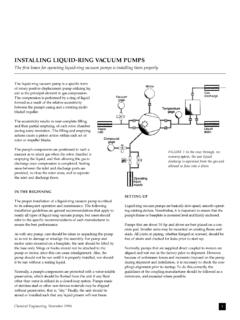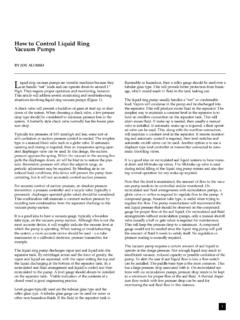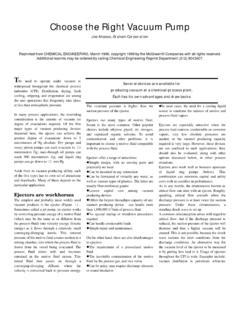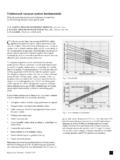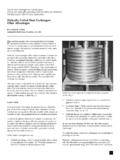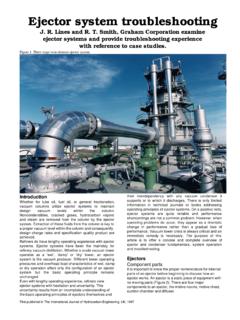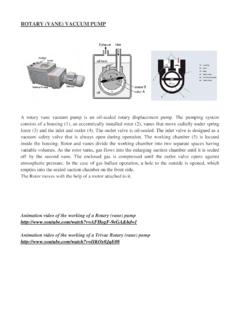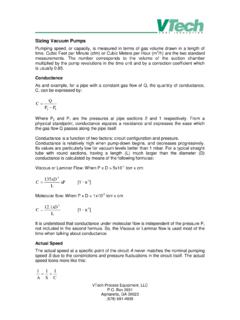Transcription of How to make sure you select the right dry vacuum pump
1 How to make sure you select the rightdry vacuum pumpBy Joe Aliasso. Unlike steam jet ejectors and liquid ring vacuum pumps , dry vacuum pumps do not requireany working fluids to create a vacuum . They operate by either gas compression, or a combination of gascompression and mechanical compression (volume reduction).The definition of a dry vacuum pump is apump that does not use any fluids to create avacuum or contact the process gas and can alsodischarge to dry vacuum rumps run hot, since there areno liquids to remove the heat created bycompressing the gas.
2 They all employ a coolingjacket to help regulate the internal temperaturein the pump, preventing excessive thermalgrowth, which would lead to failure. Timinggears with oil reservoirs and close clearancesbetween the rotors and housing are additionalattributes that make up a dry vacuum dry vacuum pumps run hot, they caneasily handle corrosive vapours with standardiron construction, as corrosion normally occursin the presence of moisture. Cast or ductile ironis inexpensive to manufacture in, and limitsthermal growth.
3 Dry pumps are notmanufactured in stainless steel or other highalloy materials because of the excessive thermalgrowth characteristics associated with thesematerials This would require larger clearancesto allow further proper thermal growth, thusresulting in a lower efficiency (morebackslippage of gas). Also, because of theincreased clearances, the ultimatevacuum would be consideration would be themanufacturing costs due to thecomplex parts that make up a dryvacuum pump.
4 Stainless steelnormally is two to three times theprice of iron. With the properselection and correct operatingprocedure, dry vacuum pumpsconstructed in iron negate the use ofstainless steel or other high similarities of the three types ofdry vacuum pumps end here. Eachmanufacturer includes uniquefeatures to differentiate their pumpfrom others. The end user shouldunderstand what features areavailable and then choose the drypump that best fits the lobe designThe rotary lobe style was the firstdry pump used in the chemicalindustry.
5 It is based on the Rootsblower principal. This design, whenproperly selected, works well withfew problems. Maintenance istypically moderate to high on thisdesign as lip seals are employed thatfrequently leak, and cleanout of thelast stage is required as buildup willoccur here. When the lip seals leak,gas can contaminate the bearing left unattended, the bearings willfail and the rotors can make lobe type pumps canemploy heat exchangers to reducethe operating temperature of thepump. If condensables are handled,then these heat exchangers cancondense under vacuum .
6 This wouldrequire a barometric leg or a complexcontrol scheme to drain out anyliquid in the rotary lobe and rotary screw type aredifficult to re-time when repairing. Setting theclearances on a rotary screw type is difficult asthe maintenance person will need to performthis on a curved surface. The rotary lobe typewill require trained personnel to set theclearances and re-time the pump screwThe rotary screw type vacuum pump can reachextremely high vacuum levels (low absolutepressures). It is in the range of 10 to 100microns.
7 Even though it can reach these levels,it cannot be used for every the rotary screw pumps run hot,actually the hottest of any of the designs,temperature sensitive materials and severeservice applications will cause problems forthis design. Polymerization can occur becauseof the operating screw pumps move the gas along thelength of the screws. Gas compression andmechanical compression does not occur untilthe final half turn of the screws. Here, immenseheat is produced. Discharge temperatures of660 F can be produced in the sensitive products and flammablegases are difficult to handle with this design.
8 Inaddition, if any wear occurs on the screws,they need to be replaced in matched sets. Otherdry pump designs allow for individual manufacturers offer a spray coating onthe screws. The purpose of this coating is forinitial fit up of the screws. This spray-oncoating is extremely thin and allows for tighterclearances to produce a better ultimate pressureand higher efficiency of the pump. As thepump is operated, the spray-on coating willwear off and affect and clawFigure 1: Lobe-type are two types of hook and claw pumpsin the market, a two-stage and a three stage produces vacuum levels lessthan 1 mmHgA by a combination of mechanicaland gas compression.
9 The two stage producesvacuum levels down to 5 mmHgA by gascompression three stage, with a combination ofmechanical and gas compression, producesdischarge temperatures of 430 F or manufacturer has solved this temperatureproblem by offering a pump that has dischargetemperatures less than 100 FA hook and claw type requires a largerfootprint and runs slightly noisier than therotary lobe and rotary screw type types of dry vacuum pumps use lip sealswith an N2 purge. Lip seals require frequentmaintenance with difficult replacement.
10 Onedesign comes standard with single mechanicalseals. This eliminates the maintenanceproblems associated with lip seals and alsoeliminates N2 handling corrosive and wet vapours, thehot running type of dry vacuum pump isdesirable. This will prevent corrosion of theiron body components. Also, for handling gasesthat can solidify at room temperature, the hotrunning type is also required to prevent anyproduct solidification inside the cool running hook and claw vacuum pumpdesign allows safe pumping of explosive andtemperature sensitive cool running hook and claw pump uses aunique discharge gas heat exchanger thatprovides for direct gas cooling.

